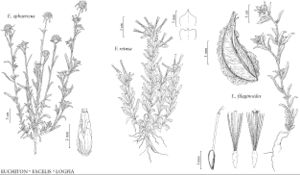Euchiton
in F. Cuvier, Dict. Sci. Nat. ed. 2, 56: 214. 1828.
| Taxon | Illustrator ⠉ | |
|---|---|---|
 | Euchiton sphaericus Facelis retusa Logfia filaginoides | Barbara Alongi Barbara Alongi Linny Heagy |
Annuals or perennials, 5–80 cm (usually fibrous-rooted, sometimes rhizomatous, usually stoloniferous). Stems usually 1, erect. Leaves basal and cauline (sometimes in rosettes); alternate; petiolate or sessile; blades oblanceolate, spatulate, lanceolate, or linear, bases cuneate or ampliate, margins entire (sometimes undulate and/or revolute), faces bicolor, abaxial usually silvery, tomentose, adaxial usually green, glabrate or glabrous. Heads disciform, usually in terminal clusters (subtended by leafy bracts, sometimes with axillary clusters), rarely borne singly. Involucres narrowly campanulate to cylindric, 3–5 mm. Phyllaries in 3–4+ series, mostly stramineous to brownish, sometimes purplish to pinkish (hyaline, stereomes not glandular), unequal, chartaceous toward tips. Receptacles flat, smooth, epaleate. Peripheral (pistillate) florets 16–150 (more numerous than bisexual); corollas purple or distally purplish. Inner (bisexual) florets 1–7; corollas purple or distally purplish. Cypselae obovoid-ellipsoid, slightly flattened, faces minutely hairy or papillate (papilliform hairs or papillae ± clavate, not myxogenic); pappi readily falling (singly or in groups), of 12–20, distinct or basally coherent, barbellate bristles in 1 series. x = 14.
Distribution
Introduced; Australia, New Zealand, New Guinea, e Asia, some species widely naturalized
Discussion
Species 17 (3 in the flora).
Selected References
Key
| 1 | Annuals; taprooted; leaf bases not clasping; bracts subtending heads 4–8; heads in globose clusters; bisexual florets 1 | Euchiton sphaericus |
| 1 | Perennials or biennials; fibrous-rooted; leaf bases subclasping; bracts subtending heads 2–5; heads in hemispheric clusters; bisexual florets 3–7 | > 2 |
| 2 | Stolons usually present; basal leaves in rosettes at flowering; cauline leaves 2–4(–6), blades linear to oblanceolate, 1–2 cm × 1–2 mm; bracts subtending heads 2–3, not surpassing heads; pistillate florets 40–60 | Euchiton gymnocephalus |
| 2 | Stolons usually absent; basal leaves withering before flowering; cauline leaves 6–10, blades mostly linear, 3–8 cm × 2–3 mm; bracts subtending heads 3–5, surpassing heads; pistillate florets 80–150 | Euchiton involucratus |